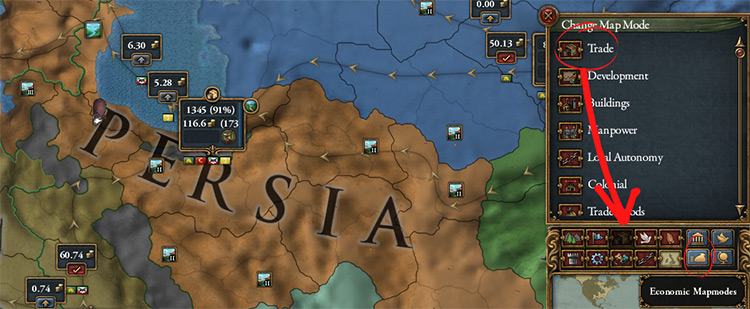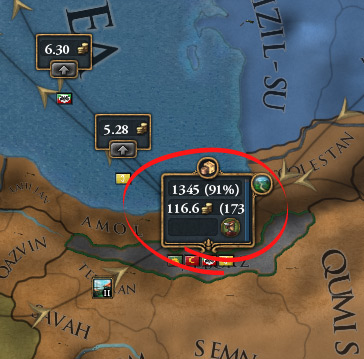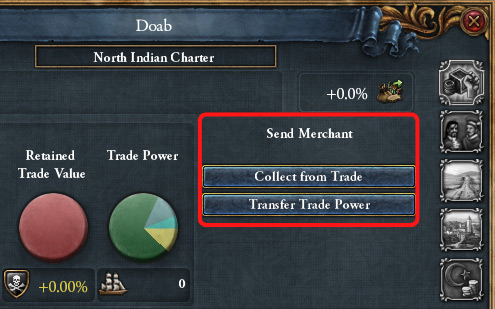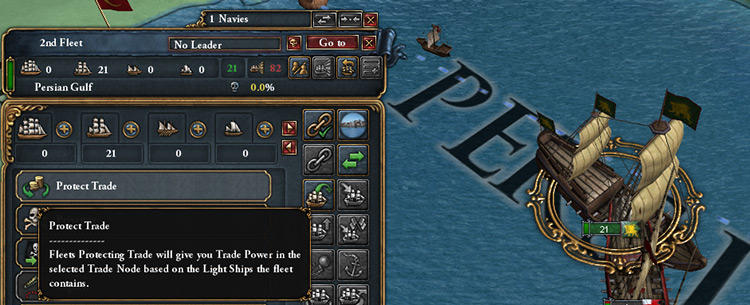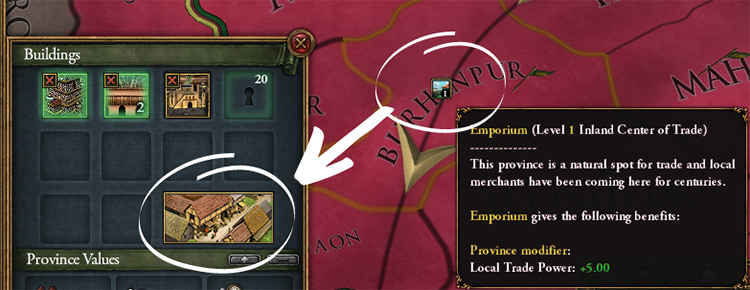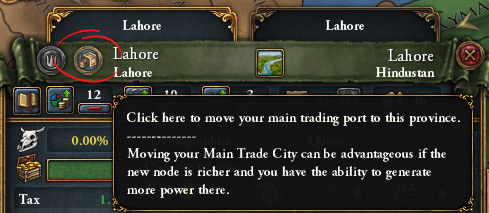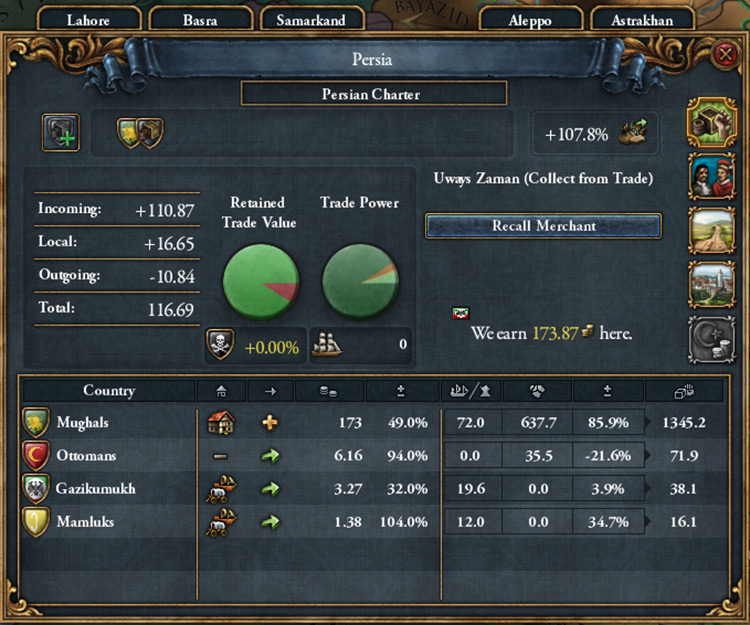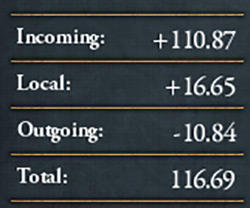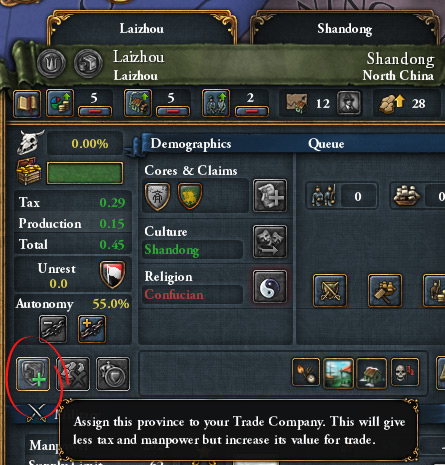To profit from it, you must first learn how it works. And this guide will cover everything you’d want to know.
Quick Guide on EU4 Trade
Note: Think of this section as a beginner’s to-do list. The terms and jargon used here will be explained further in this guide.
- Familiarize yourself with these map modes:
Economic Trade Trade Value Trade Goods Geographic Colonial and Trade Regions
Tip: You can drag their icon into a quick map slot to keep them handy. It’s recommended that you do so for the Trade map mode, as you’ll be switching to it a lot. 2. In the Trade map mode, go to your capital (hotkey: “Home”). The trade node that it belongs to is your main source of trade income. 3. Click on a trade node’s icon (the bigger one with the numbers) to open its UI. The top of it will show its connected trade nodes. The top-left are its downstream nodes; the top-right are its upstream nodes. Click on any to instantly switch to that node. 4. Open the UI for the nodes that are downstream of your home node. Assign merchants to do the “Transfer Trade” task. 5. If you have light ships, have them do the “Protect Trade” mission on your home node or its downstream nodes. 6. In the Trade map mode, the small blue square icons are centers of trade (CoTs) and estuaries. Build marketplaces on top of them and upgrade CoTs to level 2. This increases your trade power in those trade nodes. 7. Improve your provinces’ base production to raise their trade value. This also increases your trade income. Focus on those that have high-value trade goods. 8. When taking provinces in a peace deal, prioritize ones that have CoTs or high-value trade goods.
Basic Trade Terms Explained in Detail
Trade Income
You get income by “collecting value” from trade nodes, which is done in two ways: Your main trading city always collects value from the trade node it’s in. This’ll be your “home trade node”. At the start, your capital is also your main trade city. To change it to another province: This costs 200 diplo mana. Note: If an event or decision relocates your capital, your main trading city will also be moved along with it. You’ll have to designate your main trading city again, which can be a waste of diplo mana. Merchants can be assigned to a trade node that’s within your trade range. They can either collect that node’s value, or they can transfer its value to a specified node downstream. Note: Collecting value from nodes other than your home node has a -50% trade power penalty. Thus, it’s best to have your merchants transfer trade from nodes that’re upstream of your home node. You normally have 2 merchants at the start. To learn how to get more, check out this guide. Merchants also enable special trade policies on their assigned nodes. These apply certain effects:
Trade Nodes
The world is divided into predefined trade nodes. These are connected by fixed trade routes that “flow” in one direction — downstream. Certain trade nodes can be classified as origin or end nodes. Origin nodes don’t have upstream nodes where they can receive trade value from. This makes them the least valuable trade nodes. These nodes are: These don’t have any downstream nodes. There are only three of them, ranked from best to worst:
English Channel Genoa Venice
All world trade can eventually flow into these three nodes. This gives them the potential to become the richest nodes in the game.
Trade Value
To understand where a trade node gets its value, consider these two simplified equations: To put it simply, a trade node gets more trade value locally by increasing any of its provinces’ base production. Local trade value = (province’s trade good price x province’s goods produced) x trade value modifier You then add any incoming value that’s being transferred from upstream nodes. As an example, focus on this section of the previous image of Persia. Its provinces are creating +16.65 trade value. It’s receiving +110.87 trade value from upstream. -10.84 of its value is being pulled downstream. This leaves Persia with 116.69 trade value. Every province produces only one type of trade good. Their price and the amount of goods produced affect the value they add to a trade node. You can check the current prices of all trade goods in the ledger (hotkey: L). You don’t have any influence over the prices — only scripted events can change them. What you can control is a province’s base production. By improving it, you’ll increase the province’s number of goods produced. Note: Gold is a special trade good. It goes directly to your treasury rather than adding value to a trade node. Trade goods have two bonuses: To get the second one, you’ll need to be trading in at least 20% of a trade good’s global supply. You can check what the bonuses are in the ledger.
Trade Power
Trade power determines how much value a nation can collect or transfer in a trade node. In general, you want to increase your trade power in nodes with a lot of competition. A province’s trade power is based on:
+0.2 per development +2 if it’s producing silk +10 with an estuary
This is further modified by:
+2% per mercantilism stat +10% if you’ve embraced Colonialism +10% if it’s producing fur, tobacco, incense, or dye +20% if it’s producing cloves +25% if it’s a coastal province +50% with a marketplace +100% with a trade depot +125% with a stock exchange -0.5% per local autonomy -25% if its under siege -50% if its occupied
Some provinces have centers of trade. These have a special icon in the Trade map mode and in the Buildings UI. CoTs raise their province’s trade power depending on their level. You can only have a limited number of level 3 CoTs. This limit is equal to your max number of merchants. Light ships have a trade power stat. They can artificially strengthen your trade presence by doing the “Protect Trade” mission in a node. If this fleet is led by an admiral, their trade power will be increased by +5% per maneuver pip.
Trade Companies
Non-state provinces (a.k.a., territories) can be added to a trade company if:
They’re not in the same subcontinent as your capital They’re in a trade region and not a colonial region
You can add an eligible province to a trade company via their Province UI. Trade company provinces have:
+25% governing capacity cost +100% local trade power -200% missionary strength Negates all penalties from religion and culture +10% institution spread
Each one also adds +0.5 to your naval force limit. Territories with CoTs should be added to a trade company. You’re effectively doubling their trade power. Once a trade company’s provincial trade power has at least 51% of a node’s market control, you’ll get an extra merchant.
